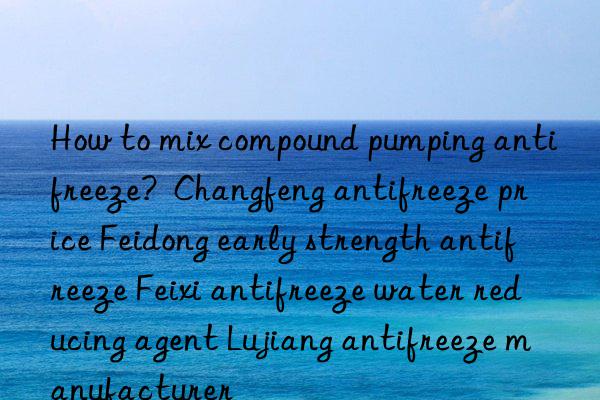
Admixtures that can harden concrete at negative temperatures and achieve expected performance under specified curing conditions are called concrete antifreeze. There are two types of antifreeze. One is an additive that can lower the freezing point so that concrete can maintain a certain liquid phase at negative temperatures and can still perform hydration, such as nitrite, chlorine salt, etc.; the other is an additive that adds Concrete has admixtures, such as alcohols, that lower the freezing point of water and interfere with the formation of ice crystals. Chlorine salt has a corrosive effect on steel bars and its use is currently restricted. Nitrite can cause alkali-aggregate reactions in concrete and is a carcinogen, and its use has been increasingly reduced in recent years. At present, ready-mixed concrete companies mostly use alcohol-based compound liquid antifreeze that is easy to measure.
Compound liquid antifreeze is composed of antifreeze, early strength, air entrainment and water reduction components.
(1) Antifreeze component. Alcohols (such as methanol, ethylene glycol, ethanolamine, etc.) are mainly used, which can not only lower the freezing point of water but also seriously deform the ice lattice structure containing this substance, so that frost heave stress cannot be formed to destroy the structure of the hydration product and make the concrete The strength is not compromised, so it is an ice crystal interference antifreeze. This type of dosage is generally 0.08%~0.1% of the mass of the cementitious material. When the amount of antifreeze is insufficient, the strength of concrete stops growing at negative temperatures, but it has no effect on the later strength after converting to positive temperatures.
(2) Early strength component. In order to make the concrete reach the critical anti-freeze strength as soon as possible, it is necessary to add admixtures that can improve the early strength of the concrete. Currently, the most commonly used is 0.05% triethanolamine + 0.5% sodium chloride early strength agent.
(3) Air entrainment component. High-quality air-entraining agents can introduce countless tiny and elastic bubbles into concrete, improve the pore structure of concrete, and reduce the freezing point of water in capillary pores. At the same time, when the water in the concrete freezes, the water in the capillary tubes can migrate to the pores, thereby reducing the frost-heaving force of the water in the capillary pores and reducing the destructive power of the freezing volume expansion of water on the concrete. The better the quality of the air-entraining agent, the better the air-entraining agent quality. The fewer bubbles introduced, the better the bubble stability, the smaller the bubble spacing, the better the frost resistance of the concrete (the amount of air-entraining agent can be based on the amount provided in the product manual).
(4) Water-reducing component. Water is the root cause of freezing damage to concrete. During winter construction, great attention should be paid to reducing the concrete water-cement ratio as much as possible, so the amount of water-reducing agent should be increased compared with normal temperature.
<img src="/upfile/202210/2022101830586343.jpg"/


 微信扫一扫打赏
微信扫一扫打赏
